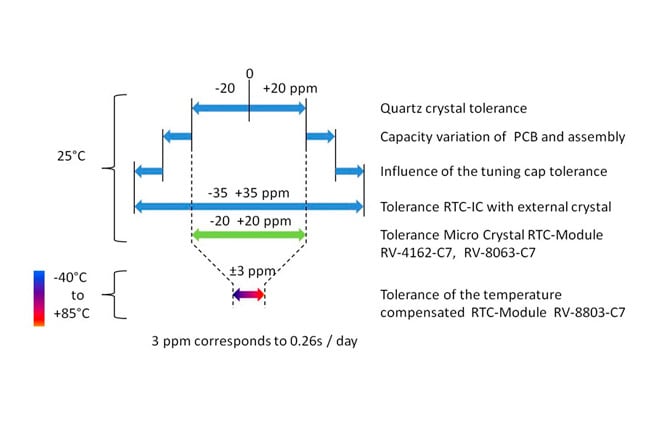Exact timing with smallest footprint
Exact timing with smallest footprint, consuming hardly any power
Tracking the actual time of a spontaneously occurring event or triggering an action of a given length at a certain point in time are best managed by a Micro Crystals RTC-module, even when the rest of the system is in power-down mode.
Tracking the actual time of a spontaneously occurring event or triggering an action of a given length at a certain point in time are best managed by a Micro Crystals RTC-module, even when the rest of the system is in power-down mode.
Micro Crystal, a division of the Swatch Group, is well known for its miniature quartz crystals applicable for a large variety of application areas including consumer, industrial, automotive and medical. The real-time clock (RTC) modules from Micro Crystal are the logical evolution from ultra-low power circuit technology in combination with state-of-the-art crystals and package technology. Having all of the components combined in a small package saves PC-board real-estate and shortens time to market.
The universal properties of the Micro Crystal RTC modules are the ideal engine for solving accurate timing tasks that are independently applicable in such market segments as portables, wearables, IoT, testing and measurement, automotive and medical among others.
The integration of the RTC circuit together with the Xtal to build an RTC module provides five major advantages to our customers:
1. The oscillator works at the optimal operating point;
2. There is enhanced precision and improved timing accuracy;
3. There are smaller space requirements;
4. There is insensitivity to environmental conditions like humidity, EMC, spikes, etc.;
5. There is a solid basis for optimal temperature compensation.
1. The oscillator working at the optimal operating point
1. The accuracy of the RTC is influenced by the components of the oscillator. The tolerances of the Xtal are part of the equation as are the parasitics of the PC-board.
2. Through integration, Micro Crystal is able to minimize and compensate the spread of the components to outperform the accuracy of discrete solutions (RTC chip with external Xtal).
2. Enhanced Precision
For accurate timekeeping, the oscillator is calibrated at 25°C. During the module’s final electrical test, the precision is verified again. The tolerance of the entire circuit is now as low as that of the quartz alone.
3. Reduced size
Continuously increased integration density of the semiconductor processes have reduced the RTC block size to << 1mm2; compared with the size of the bond pads and suitable SMD package, the interconnect overhead is considerable. The manufacturing technologies for the 32 kHz tuning fork crystals have also progressed in parallel. Since 32 kHz crystals show the best performance under vacuum, Micro Crystal has now developed a miniature package hosting the quartz and the semiconductor circuit together in the same cavity. By connecting the Xtal internally with the integrated circuit, two external pads could be eliminated. The complete RTC-module compares in size to a 1206 chip-cap (3.2 x 1.5mm).
4. Robustness in respect to environmental conditions
The ceramic package is hermetically sealed and offers protection from external environmental changes. High humidity or dust contamination have no influence on the oscillator’s performance. Tight connections between the Xtal and the chip inside the module enhance the robustness, filtering unwanted interference signals.
5. Optimal temperature compensation
Piggybacking the Xtal and integrated circuit in one small package is the optimal prerequisite for accurate temperature compensation. Both components track the same temperature; therefore optimal frequency compensation over a large temperature range is achieved (-40°C to +85°C).
Advanced applications with real-time clock modules
Aside from the obvious tasks of tracking time and date, a number of microcontroller functions are moved to the RTC with the objective of reducing power consumption during power-down mode.
a) Time stamp:
Special events trigger an internal interrupt to latch the actual time. This function has no impact on the power consumption. Different functions may trigger a time stamp, e.g. changed signals at the event input or the time of switch-over to battery back-up mode.
b) Timing short or long periods accurately:
A desired period can be precisely controlled. For short periods in the range of milliseconds to several minutes, the internal timer is the best choice. Longer periods are better achieved with the alarm facility. Applications like controlling the measuring intervals (length and pause) or switch-off delays can easily be programmed to work without the involvement of the microcontroller. This also has no impact on the current consumption. The microcontroller will be “awakened” at the end in time to carry out the necessary following action.
c) Monitoring the microcontroller with a “watchdog”:
Increasingly, blue books for new applications require a so-called autonomous watchdog to monitor the software. For example, if the microcontroller is waiting for an external signal which will inadvertently no longer occur, the watchdog will interrupt the controller after a given time to take resetting action, thus preventing the program from staying in an endless loop.
The Internet of Things (IoT)
The desire to link all components at home and in the industry does not exclude physically small units. We find notably tight conditions with wireless sensors, data loggers and actuators. Micro Crystal’s modules offer full RTC functions in the size of a 1206 SMD component. The interfaces I2C and SPI make it possible to place them anywhere on the board.
Micro Crystal offers three RTC modules in the miniature C7 package:
RV-4162-C7: the standard I2C-Bus RTC with 1/100s resolution. Along with the watchdog function and a frequency generator, it also continuously monitors the oscillator’s performance.
RV-8803-C7: the industry’s best RTC, featuring the highest accuracy and the lowest power consumption in the smallest package.
RV-8063-C7: a standard RTC with SPI interface similar to the RV-4162-C7.
(Autor: Markus Hintermann, Micro Crystal AG)


